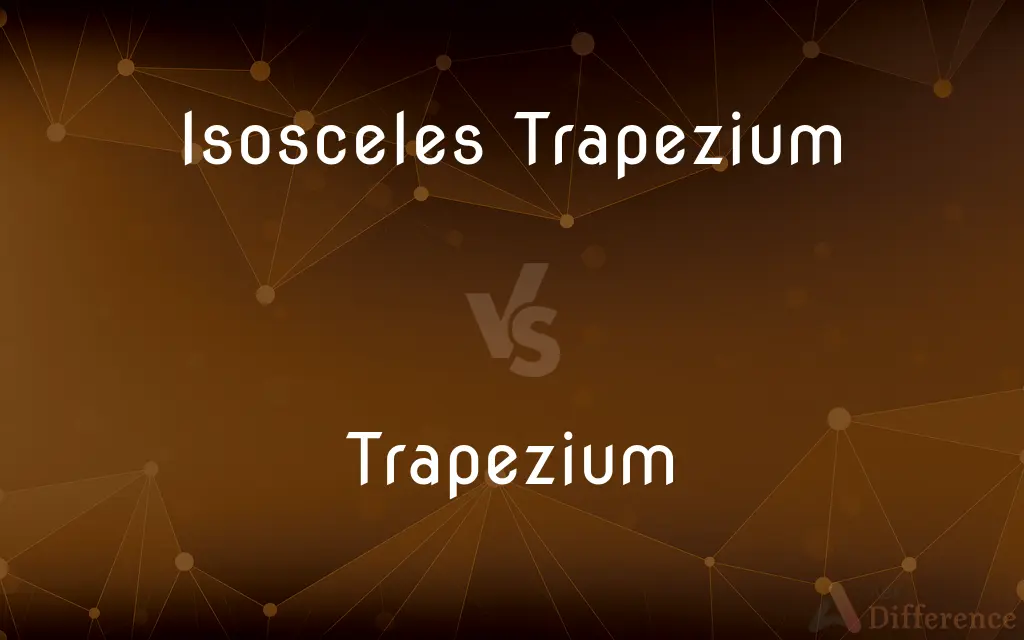Isosceles Trapezium vs. Trapezium — What's the Difference?
By Tayyaba Rehman — Published on January 24, 2024
An isosceles trapezium is a trapezium with two non-parallel sides of equal length, while a general trapezium is a four-sided figure with only one pair of parallel sides.

Difference Between Isosceles Trapezium and Trapezium
Table of Contents
ADVERTISEMENT
Key Differences
Definition and Shape: An isosceles trapezium is defined by its equal-length non-parallel sides, creating a mirror symmetry. A trapezium, however, simply has one pair of parallel sides and doesn't require equal-length non-parallel sides.
Symmetry and Properties: The isosceles trapezium not only has two equal non-parallel sides but also has equal angles at the base. A general trapezium lacks these symmetrical properties and can have varied angles and side lengths.
Geometric Applications: Isosceles trapeziums are often used in geometric problems involving symmetry and angle calculations. General trapeziums are more versatile in general shape discussions without specific symmetry requirements.
Practical Examples: Isosceles trapeziums are often seen in architectural designs for aesthetic symmetry, while general trapeziums are more common in various irregular shapes and forms in everyday objects.
Comparison Chart
Non-Parallel Sides
Equal length
Unequal length
ADVERTISEMENT
Symmetry
Symmetrical with equal angles at the base
No symmetry required
Angles
Two pairs of equal angles
Angles can vary widely
Geometric Use
Common in symmetry-based problems
Used for general shapes with one pair of parallel sides
Aesthetic Application
Preferred in designs for symmetrical appeal
More diverse applications due to irregular shape
Compare with Definitions
Isosceles Trapezium
A symmetric trapezium with equal angles at each base.
In our geometry class, we learned how to calculate the area of an isosceles trapezium.
Trapezium
A polygon in geometry that does not conform to stricter quadrilateral classifications.
In our math problem, we had to calculate the area of a trapezium.
Isosceles Trapezium
A trapezium with a line of symmetry between its non-parallel sides.
The isosceles trapezium in the art piece added a sense of balance.
Trapezium
A common shape in everyday objects where two sides are parallel.
The tabletop's trapezium design added a unique touch to the room.
Isosceles Trapezium
A quadrilateral with a pair of parallel sides and non-parallel sides of equal length.
The garden's layout was designed in the shape of an isosceles trapezium.
Trapezium
A quadrilateral having no parallel sides.
Isosceles Trapezium
A four-sided figure with one pair of parallel sides and another pair of congruent sides.
We used an isosceles trapezium to demonstrate properties of symmetry in math.
Trapezium
Chiefly British A trapezoid.
Isosceles Trapezium
A geometric shape used in design for its mirror symmetry along one axis.
The building's façade featured an isosceles trapezium, creating an aesthetically pleasing symmetry.
Trapezium
(Anatomy)A bone in the wrist at the base of the thumb.
Trapezium
A quadrilateral with two sides parallel.
Trapezium
(restrictively) A quadrilateral with two sides parallel and two sides non-parallel.
Trapezium
A four-sided polygon with no parallel sides and no sides equal; a simple convex irregular quadrilateral.
Trapezium
(anatomy) The trapezium bone of the wrist.
Trapezium
A region on the ventral side of the brain, either just back of the pons Varolii, or, as in man, covered by the posterior extension of its transverse fibers.
Trapezium
A plane figure bounded by four right lines, of which no two are parallel.
Trapezium
A bone of the carpus at the base of the first metacarpal, or thumb.
Trapezium
A quadrilateral with no parallel sides
Trapezium
A multiple star in the constellation of Orion
Trapezium
The wrist bone on the thumb side of the hand that articulates with the 1st and 2nd metacarpals
Trapezium
A quadrilateral with only one pair of parallel sides.
The plot of land was shaped like a trapezium, making construction challenging.
Trapezium
A four-sided figure with uneven sides and no symmetry requirement.
She drew a trapezium to demonstrate an irregular quadrilateral in class.
Trapezium
A geometric shape used in various applications due to its versatility.
Trapezium shapes are often seen in modern art due to their unique properties.
Common Curiosities
What defines an isosceles trapezium?
It's a trapezium with equal non-parallel sides and equal angles at each base.
Is symmetry a feature of all isosceles trapeziums?
Yes, they have a line of symmetry between the non-parallel sides.
What's a basic trapezium?
A quadrilateral with only one pair of parallel sides.
Can a trapezium have right angles?
Yes, but not necessarily.
What's the difference in angles between isosceles trapeziums and regular trapeziums?
Isosceles trapeziums have two pairs of equal angles, while trapeziums can have varied angles.
Do trapeziums have equal sides?
Only in the case of isosceles trapeziums.
Are isosceles trapeziums commonly used in architecture?
Yes, for their symmetrical aesthetic appeal.
Are all isosceles trapeziums similar in shape?
Their basic structure is similar, but dimensions can vary.
Can trapeziums be used in geometric proofs?
Yes, especially in discussing properties of quadrilaterals.
Can isosceles trapeziums have right angles?
Yes, if the non-parallel sides are perpendicular to the bases.
What is the significance of the parallel sides in isosceles trapeziums?
They define the shape and are key in calculating the area and other properties.
Are trapeziums always irregular?
Generally, yes, except for special cases like isosceles trapeziums.
Is it easier to calculate properties of an isosceles trapezium compared to a regular trapezium?
Often, yes, due to the symmetry and equal angles in isosceles trapeziums.
Can the sides of a trapezium be of any length?
Yes, as long as there's one pair of parallel sides.
Share Your Discovery

Previous Comparison
Bratwurst vs. Italian Sausage
Next Comparison
Fullmetal Alchemist vs. Fullmetal Alchemist BrotherhoodAuthor Spotlight
Written by
Tayyaba RehmanTayyaba Rehman is a distinguished writer, currently serving as a primary contributor to askdifference.com. As a researcher in semantics and etymology, Tayyaba's passion for the complexity of languages and their distinctions has found a perfect home on the platform. Tayyaba delves into the intricacies of language, distinguishing between commonly confused words and phrases, thereby providing clarity for readers worldwide.














































